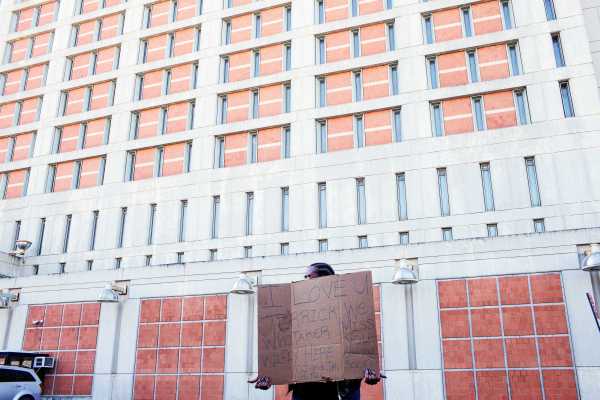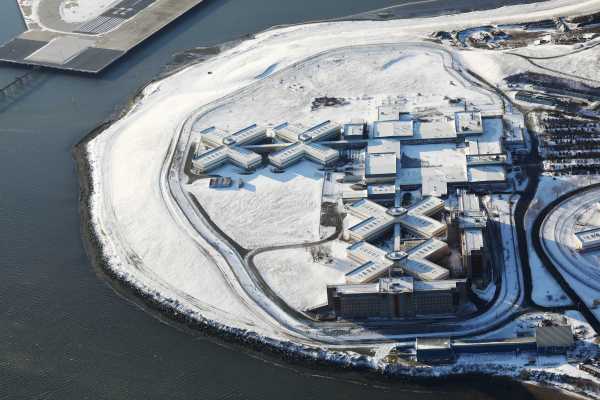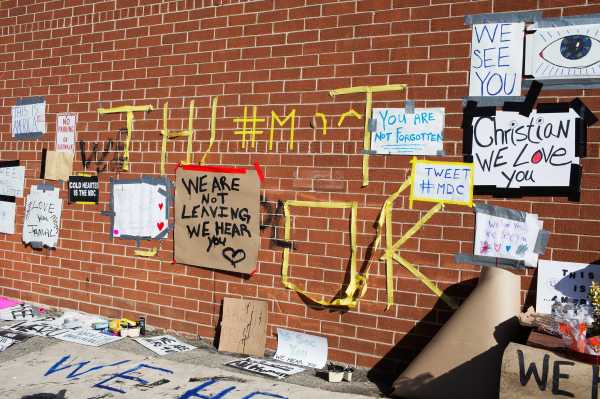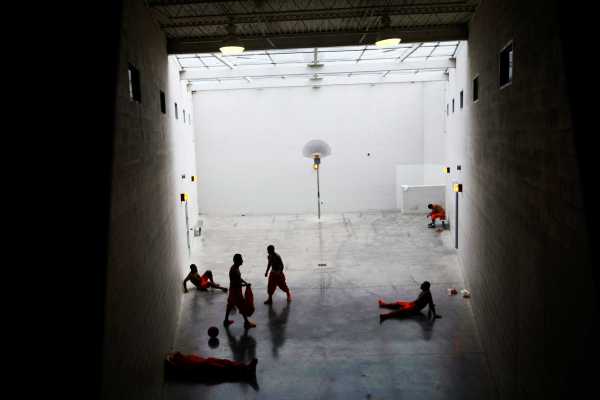
Why people are freezing in America’s prisons
It shouldn’t be up to concerned citizens to keep the incarcerated warm in the winter.
By
Roxanna Asgarian
Dec 13, 2019, 9:20am EST
Share this story
-
Share this on Facebook
-
Share this on Twitter
-
Share
All sharing options
Share
All sharing options for:
Why people are freezing in America’s prisons
-
Reddit
-
Pocket
-
Flipboard
-
Email
As New York temperatures dropped in early December, a public defender in Brooklyn tweeted a request for warm clothing for those incarcerated on Rikers Island. “It’s freezing outside. It’s even colder on Rikers,” Scott Hechinger wrote to his nearly 70,000 followers. “Right now, people are walking around in the blanket they’re provided. Literally shivering. Guards open windows to spite them.”
Hechinger asked for help filling an Amazon wishlist of thermal underwear, socks, and undershirts — items that have been approved by the NYC Department of Corrections for use in city jails. These are also items many would assume the Department of Corrections would provide for incarcerated people themselves.
When asked about the need for warm clothes, Peter Thorne, the deputy commissioner of public information at the New York City Department of Corrections, told Vox that the agency works to ensure people in its custody don’t get too cold. “We take numerous precautions including taking regular temperature readings, providing blankets if needed, and even relocating individuals if a cold temperature situation can’t be quickly resolved,” Thorne said. “The Department takes all complaints about conditions inside our facilities seriously.”
But Kelsey De Avila, the jail services project director at Brooklyn Defender Services (BDS), where Hechinger works, said that their clients are telling a different story. BDS started its clothing drive in 2016 after clients said they were freezing in jail and weren’t getting issued the warm layers they were requesting.
“Every year we hear the same complaints. In the winter people are cold, they aren’t getting the required warm clothing that the DOC is supposed to provide for people, the sweats and blankets,” De Avila said. “[Our clients are saying] the heat hasn’t been turned on, windows are broken so cold is coming into the units, and when they ask for the clothing, they have to beg or ask multiple times.”

The drive has been increasingly successful each year, with people around the country donating items to New York City jails. So far, hundreds of orders have come in since Hechinger’s tweet. But De Avila stresses that it’s just a band-aid on the problem of inadequate temperature control in jails and prisons.
Because the US system of prisons and jails is so vast — including 50 state prison systems, the federal prison system, and nearly 3,000 jurisdictions that include cities, counties, and Indian reservations — and because there are no federally mandated laws on temperature control, American prisoners are exposed to a wide range of conditions. Even at the state and local levels, there are few laws around this, leaving incarcerated people at the mercy of the courts to implement protections for them. And if the courts won’t provide these rights, incarcerated people have to rely on the goodwill and donations of concerned citizens to stay warm through the winter.
But in many jails, outside charity isn’t even allowed. The lack of warm clothes is just one of the indignities many incarcerated people face in a bureaucratic system that isn’t set up to shelter them.
America’s prisons are often too cold in the winter, too hot in the summer
Last winter, more than 1,600 incarcerated people in a Brooklyn federal prison spent about a week with “limited heat and power” as outside temperatures neared zero degrees Fahrenheit. The Bureau of Prisons, which oversees the Metropolitan Detention Center (MDC), told the New York Times that there was a partial power outage but that cells did have heat. Ultimately, it blamed the outage on the utility company Con Edison, which denied responsibility.
In response to the report, protests were staged outside the facility in Brooklyn’s Sunset Park neighborhood. The media attention, coupled with the urging of local politicians, resulted in heat being restored — but it took more than a week to do.
De Avila said that due to the policies at MDC, Brooklyn Defender Services couldn’t even deliver warm clothes from its drive to the MDC prisoners. And it’s clear, De Avila stresses, that this problem is not limited to one specific instance — people detained in ICE custody in New Jersey jails also complain of the cold and are also not able to receive the items. “We have to go through approved vendors, which are marked up astronomically,” De Avila said. (An ICE spokesperson told Vox that “allowing such donations could present a security and/or health risk to those housed in ICE’s care,” but that standards do require ICE to provide weather-appropriate clothing.)
The problem of frigid prison conditions is ongoing throughout the country. In January 2018, the Texas Tribune reported that more than 30 prisons in the state had inadequate heating during a cold snap. And just last month, incarcerated people in Dauphin County, Pennsylvania, told the PA Post that their cells were so cold they could see their breath, something the outlet says happens at around 45 degrees. “It’s a recurring issue every winter,” De Avila said.
So, too, is the opposite problem — extreme heat inside prisons during the summer, which has received more attention in recent years in part because of heat-related deaths of prisoners. At least 23 incarcerated people have died due to extreme heat since 1998 in Texas prisons alone. A report from the Prison Policy Initiative found that 13 states with hot summer climates don’t have universal air conditioning, and a 2015 Columbia University report notes that, in light of climate change, the problem is getting worse.

And yet this isn’t a new problem. A 1991 Human Rights Watch report found that prisoners from New York to Tennessee to Florida raised concerns about temperature control. “In almost all institutions Human Rights Watch visited, we heard complaints about the temperature,” the report stated. “At Starke [in Florida], many inmates complained about heat in the summer and cold in the winter; the same concerns were voiced by prisoners at the Tennessee State Penitentiary in Nashville. Most institutions we visited, including those in hot climates, were not air conditioned.”
De Avila said that any time a client complains of frigid conditions, or when a client shows up to court without the standard-issue coat they are supposed to be given when leaving the jail, their lawyer helps them to file a complaint. “For every person who came to court without a coat, we’d send an email, and it was just one after another,” she said. It would take this nudge for a coat to be provided.
The New York City DOC maintains that temperatures are monitored regularly in its jails and prisons, and that the warden is required to be notified when temperatures dip under 68 degrees. Maintenance is required to respond, providing blankets and hot beverages, and incarcerated people are moved if the problems can’t be resolved, the DOC said. If there are problems, grievances can be filed by prisoners, or they can call 311 to report the complaint.
However, like with MDC last winter, addressing major issues often comes only after media attention or activism — and that results in quick fixes, instead of permanent change.
Facilities have patchwork guidelines and few specific laws on temperature regulation
There are no federal laws mandating temperature control in prisons and jails. An FAQ on the website for National Institute of Corrections (NIC), the federal agency intended to support corrections agencies across the country, gives a complex answer to the question of ideal temperature. “Not everybody ‘feels’ temperature or comfort the same,” it begins. Still, NIC requires that the warden and the assistant commissioner be notified when temperatures drop below 68 degrees in all areas and are above 80 degrees in specific areas.
A Federal Bureau of Prisons operation manual from 2016 states that temperatures “will be targeted to 76 degrees Fahrenheit in the cooling season and 68 degrees Fahrenheit in the heating season,” but adds that “due to issues such as the age of the cooling and heating systems and the inability to control temperatures in individual spaces, occupants may experience a range of temperatures in their space that is a few degrees on either side of the targeted set point.”
Alexi Jones, a policy analyst for the Prison Policy Initiative who authored the air conditioning report, said there is a lack of federal, state, and local legislation around temperature control in jails and prisons, leaving much up to the discretion of corrections officials. “There may be guidelines, but there are very few actual laws that regulate it,” Jones said. “Between county jails, state prison systems, and federal prison systems, it’s a very patchwork system of regulations on temperature control.”
In Texas, for instance, county jails must be kept between 65 and 85 degrees, but that requirement does not extend to state prisons. A recent bill to require state prisons to implement those guidelines was scrapped in favor of a “cost study” in 2019; the legislature won’t get another crack at passing the law until it meets again in 2021. In West Virginia, temperatures “must be maintained appropriate to the summer and winter comfort zones with consideration for the activity performed” — without specifying what those comfort zones are. Alaska calls for temperatures between 65 and 85 degrees “when feasible.”
Loose guidelines are often not enough to ensure proper treatment of incarcerated people, Jones said, especially within a broader culture of prisoner mistreatment. “When people think of the cold and heat in prisons, they may not realize how little freedom incarcerated people have,” she said. “If you want an extra blanket, that’s a request you have to put in that may or may not be denied. Just the most basic things are not options that are available a lot of the time.”
And, of course, not every jail or prison in America is supported by an Amazon wishlist. For incarcerated people around the country, access to warm clothing, as well as the quality of other necessities such as education and medical care, is largely dependent on the facility in which they’re housed. “They are so dependent on the prison or jail they’re in to have their basic needs met — and it feels more astonishing that jails and prisons aren’t providing [warm clothes or blankets] because people in jails prisons have no other option,” Jones said.

These types of requests typically fall to corrections officers, who have a large amount of discretion in dealings with incarcerated people. Few are punished for these kinds of withholding behaviors, and so there is little incentive for them to provide the things prisoners request unless there is a lot of attention on a particular case.
So far, advocates have pursued lawsuits to earn rights for prisoners that legislation has failed to ensure. In 2017, for instance, after a protracted battle, a federal judge ruled that Texas violated the rights of a class of plaintiffs housed in the William Pack Unit, which regularly topped 100 degrees. The state agreed to keep temperatures in the Pack Unit at below 88 degrees; inmates in other Texas units are now suing in similar cases. Still, in September, a federal judge threatened to put state officials in sweltering cells themselves for failing to implement the judge’s order for air conditioning in the unit in a timely way.
In New York City, a lawsuit regarding the substandard conditions in jails in the 1970s led to the creation of an independent monitoring committee, supervised by a judge, to ensure conditions are livable in the city’s jails. In 2008, after the Department of Corrections moved to terminate the order, which in part governs the treatment of “heat sensitive” prisoners and their right to air conditioning, US District Judge Harold Baer ruled to keep the order in place, noting that the jails had been routinely found to be noncompliant with the terms of the decree. In a paper that year for the New York Law School Law Review, Baur said the courts have a duty to step in where other branches of government aren’t. “In such instances when the legislature and the executive are unable or unwilling to insure minimal constitutional rights,” Baur wrote, “that judicial intervention has been and should continue to be a viable solution.”
And while there are no federal laws about regulating temperatures, federal courts have found that extreme temperatures can be a violation of prisoners’ rights to be free of cruel and unusual punishment, such as in a 1991 case where the Supreme Court recognized that low cell temperatures and a failure to issue blankets could be an Eighth Amendment violation. Federal courts have also recognized temperature control as part of pretrial detainees’ rights to due process, such as in a case in Arizona where a federal appeals court instituted federal oversight of Maricopa County jails to ensure livable conditions, including livable temperatures.
Revisiting the MDC incident in Brooklyn, the Bureau of Prisons released a report in September that called the weeklong power outage during a polar vortex “a media crisis.” It made recommendations, including upgrading the heating systems and making warm-weather clothes standard-issue. But the warden, Herman Quay, who had misled reporters and politicians about the extent of and the reasons for the heat and power problems, has since been promoted to oversee twice as many incarcerated people in his new post in Pennsylvania, the Intercept reported. No laws have since changed regarding temperature controls in federal prisons.
In the absence of systemic change, grassroots advocates will continue agitating for new laws, and organizations like Brooklyn Defender Services will continue to solicit donations of warm clothes from well-meaning people around the country to fill the gaps.
“It’s so heartwarming and overwhelming, but also, we really shouldn’t have to be doing this,” De Avila said of the clothing drive. “The department has a responsibility to ensure people are provided with humane conditions, warm clothing. They shouldn’t have to beg for certain basic essential items.”
Sourse: vox.com






